
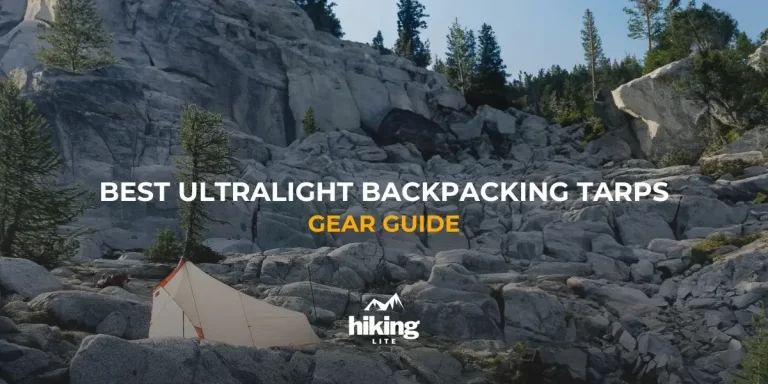
When heading out into the backcountry, having a high-quality shelter is a top priority. While tents remain a popular choice, a lightweight backpacking tarp can be a versatile and low-impact alternative.
With so many tarp options on the market nowadays, it can be difficult to choose the right one for your needs and trip.
Some important specifications to examine include the tarp’s strength, size, ease of setup, weight, and durability. A backpacking tarp needs to withstand wind and rain while providing adequate coverage. Its size will determine if you feel cramped or exposed.
With these selection criteria in mind, we’ve identified our top 5 recommendations for the best tarps for backpacking in 2024.
Let’s get started.

Key Specs
Weight: 5.1 ounces (144g)
Size: 7′ x 9′ (2.1 m x 2.7 m)
Material: DCF
Price: $$$
PROS
✅ Ultralight
✅ Small pack size
CONS
❌ None
The Flat Tarp from Zpacks is a great shelter for backpackers who like simple setups. This tarp gives you lots of room for your sleeping pad and gear.
It’s really easy to put up and provides strong protection from rain. You can arrange it different ways so it covers more space in nasty weather too.
The tarp is made from Dyneema Composite Fabric. It stays dry without needing special treatments like seals or waterproofing chemicals. And even better, the Flat Tarp is super lightweight and packs down tiny.
We shared our experience using the tarp in heavy rain and snow in Yellowstone. For over three days it rained constantly when the temperature barely got above freezing. The tarp saved us from getting soaked every time we stopped to rest or make camp.
We said if you want an affordable shelter that’s really lightweight, this tarp is the way to go. With its simple design and quality materials, the Flat Tarp is a great choice.
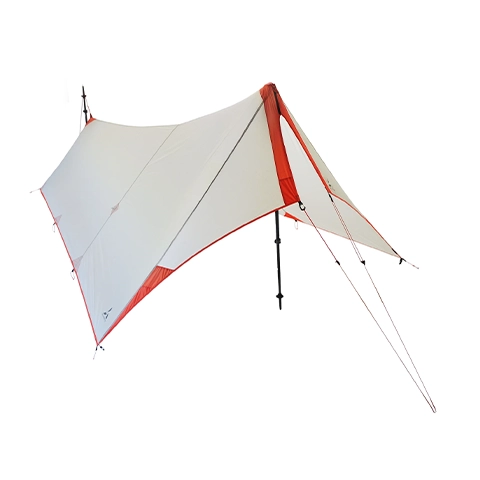
Key Specs
Weight: 7.9 ounces (224g)
Size: 5.9′ x 7.5′ (1.8 m x 2.3 m)
Material: 10D nylon ripstop
Price: $$
PROS
✅ Great in bad weather
✅ Additional accessories available
CONS
❌ None
The SplitWing tarp from SlingFin is designed for ultralight backpackers who want lightweight gear that still protects from bad weather. It’s perfect for long trips like thru-hikes since it adapts to different conditions and can comfortably fit one or two people.
At only 7.9 ounces, it’s incredibly light. Strong reinforced fabric and unique pitching options keep it durable in tough conditions. Additional accessories like a vestibule and mesh body increase versatility, balancing minimalism and tent-like comfort.
It withstands rain, hail and snow with no seam sealing required. On wet nights it may droop slightly but not enough to cause issues. It had less condensation expected.
The door was simple but worth the two extra ounces. This lowered our base weight significantly for a good price.
Overall, the SplitWing earned our highest recommendation for its ultralight design and durability. Whether seeking base weight savings or reliable multi-month shelter, this tarp delivers exceptional performance.
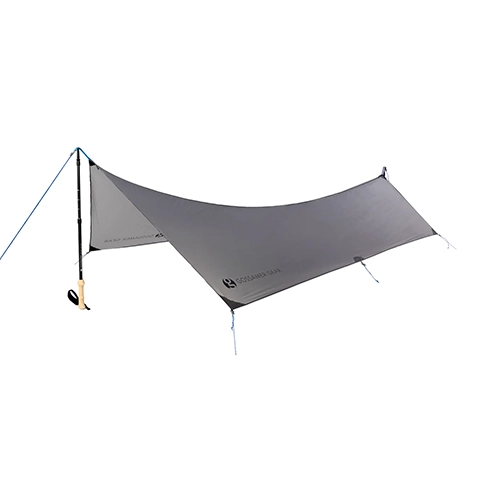
Key Specs
Weight: 7.12 ounces (202 grams)
Size: 5-7′ x 8.92′ (1.52-2.13 m x 2.72 m)
Material: 10D nylon SIL/PU
Price: $
PROS
✅ Great in bad weather
✅ Small pack size
CONS
❌ No manufacturer bug net available
The Solo Tarp from Gossamer Gear is an exceptionally lightweight and compact shelter that protects against the elements.
The clever catenary cut achieves an optimal balance of coverage and packability. When severe weather hits, the reinforced seams and waterproof coating shield campers admirably.
Thoughtful details like sidewall tie-outs and factory-taped seams ensure structural integrity so backpackers need not worry about leaks or durability.
While Gossamer Gear does not bundle a net, strategic loops permit attaching optional netting to contain bugs. Therein lies the Solo Tarp’s only caveat – the lack of an integrated netting may be less than ideal for insect-prone areas.
Nonetheless, for adventurers seeking sheer lightweight shelter, this product truly delivers. Overall, given reasonable cost and performance, the Solo Tarp stands out as a sensible protection choice for solo trekkers minimizing pack weight.
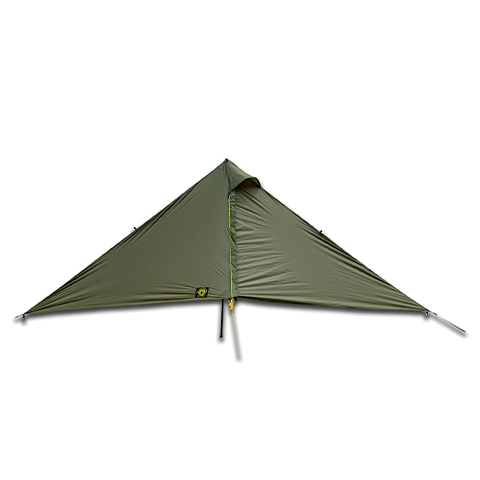
Key Specs
Weight: 12.98 ounces (368 grams)
Coverage: 44 ft² | 4 m²
Material: 20D nylon
Price: $$
PROS
✅ Good protection from the elements
✅ Relatively easy to set up
CONS
❌ Minor quality issues
The Deschutes Tarp from Six Moon Designs is an exceptionally light and packable shelter designed for minimalist backpackers.
Despite its small footprint, this tarp provides generous interior coverage and comfortable sleeping quarters through a clever pyramid design.
The 360-degree protection from wind and precipitation makes it well-suited for extreme conditions. Setup requires just one adjustable trekking pole, contributing to quick pitch times even in inclement environments. Additionally, stakes keep the shelter stable during high winds and light snowstorms.
While the tarp focuses on weather resistance over insect barriers, purchasing the optional Serenity NetTent transforms it into a double-walled solo tent. This enhances versatility for different terrains and seasons.
At a mere 13 ounces, durability does not come at the cost of excessive weight. Thoughtful details like the floating floor and hexagonal shape maximize interior space relative to the small packed size.
One user lamented that poorly dried seam sealing caused the fabric to stick together inconveniently out of the bag.
However, for its protection, and affordable price point, the Deschutes remains a sensible ultralight shelter choice.
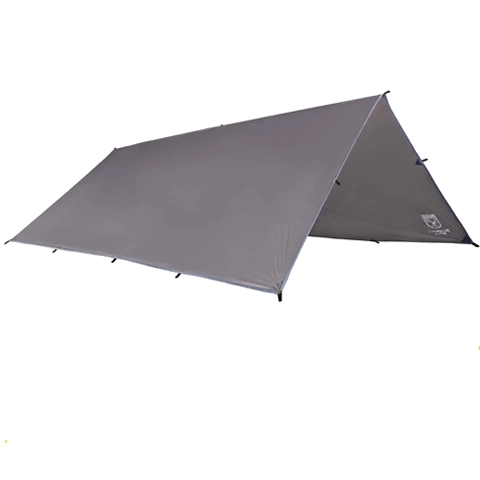
Key Specs
Weight: 20.5 ounces (581 grams)
Size: 8′ x 10′ (2.43 m x 3.05 m) (flat tarp)
Material: 30D nylon ripstop
Price: $
PROS
✅ Various shapes and sizes available
✅ Relatively affordable
✅ Good for hammock camping
CONS
❌ More top tie outs would be nice
The Sanctuary SilTarp from Paria Outdoors is a great pick for people who love hiking with lightweight gear and need a shelter that can handle different situations.
It comes with a big tarp made of tough silicon nylon, sturdy ropes, adjusters, and stakes, giving you lots of options for setting it up. You can use it in different styles like using trekking poles to make an A-frame, hanging it overhead, or cutting it in a special way for better wind resistance.
The materials are strong and waterproof, thanks to a special coating and sealed seams. And it’s really light, weighing between 14 to 27 ounces depending on the size, so it won’t weigh you down.
We really liked the 8×10 size because it covers a lot of ground, but we did find that the way the seams are placed means you need to set it up with a ridge in the middle, which might be unexpected for some.
If you’re camping in places where water might collect, the tapered version with a mesh bivy is a better choice. It keeps you dry and also keeps out bugs during storms.
Overall, the Sanctuary SilTarp is a good option if you want a shelter that you can customize, that keeps you dry, and that doesn’t cost too much.
When it comes to lightweight shelter, a versatile tarp is an ultralight backpacker’s best friend.
Here are the top factors to consider when choosing one:
Weighing Weight and Size
For many hikers, ounces matter! Assess each tarp’s stated weight and how compactly it packs down. Lighter options allow for further distances between resupplies. Compare packed sizes – can it squeeze into a side pocket or does it require its own bag? The smallest tarp that meets your other criteria lets you maximize mileage.
Evaluating Durability and Weather Protection
The absolute lightest tarps use thin materials that puncture or tear more easily. Honestly evaluate potential conditions like prolonged rain or wind gusts. Do you need full protection, or is a tarpshell sufficient? If tough conditions are likely, a mid-weight tarp with more durable fabrics may be worth the extra ounces.
Sizing Up Coverage and Shape
Solo travelers are best with tapered or rectangular tarps. But for groups or those wanting spacious living quarters, a square tarp provides generous real estate. Consider your planned group size and total gear footprint.
Adding Accessories and Modularity
Integrated mesh, rainflys, vestibules provide coverage without much weight. Trekking pole or freestanding setup broadens usable locations. Modular components add weather protection on demand.
To delve deeper into the types of tarps, be sure to explore our comprehensive post here.
When choosing the best tarp for backpacking, consider weight, pack size, UV resistance of the material, coverage, versatility of setup options using tie-downs and trekking poles or stakes in an emergency, and look for ripstop fabrics that provide good coverage without added weight. A versatile design that can be used as an emergency bivy, hammock shelter, or with additional mesh or bathtub floors to keep bugs out will serve you better than single-use tarps that don’t cover your needs.
The ideal size for a backpacking tarp depends on your needs – solo travelers may prefer a small triangular or rectangle style around 5×7 feet to cut ounces, while 2-3 person groups would benefit from 7×9 or larger square tarps with enough coverage to sit up and stash gear. Look for multiple attachment points like grommets around the perimeter and corners to pitch the tarp in various configurations using stakes or your hiking poles as tie points. A good target size is at least large enough to cover your sleeping pad and shelter with an optional groundsheet or bathtub-style footprint, but avoid overly massive tarpaulins that are clumsy and provide no real benefit over a small sheet for most backpacking applications.
When it comes to materials for backpacking tarps, lightweight and durability are key. Look for ripstop nylon or silnylon fabrics of 1.0-1.2oz/sqyd that shed water well and won’t tear from brush or punctures. Heavier duty tarps may use 1.6-2.0oz materials. Coated fabrics with a PU or silicone treatment provide better water resistance than bare nylons. Dyneema composites like DCF (denier cordura fiber) are extremely lightweight and strong, but are more expensive and prone to abrasion. Avoid heavy-duty vinyl tarps as they are bulky and hot; breathable nylon is cooler for backpacking. While silpoly fabrics and cuben fiber are very strong and light, they generally cost more and are prone to abrasion, so may not stand up to heavy use as well as mid-weight ripstop nylon for most applications.